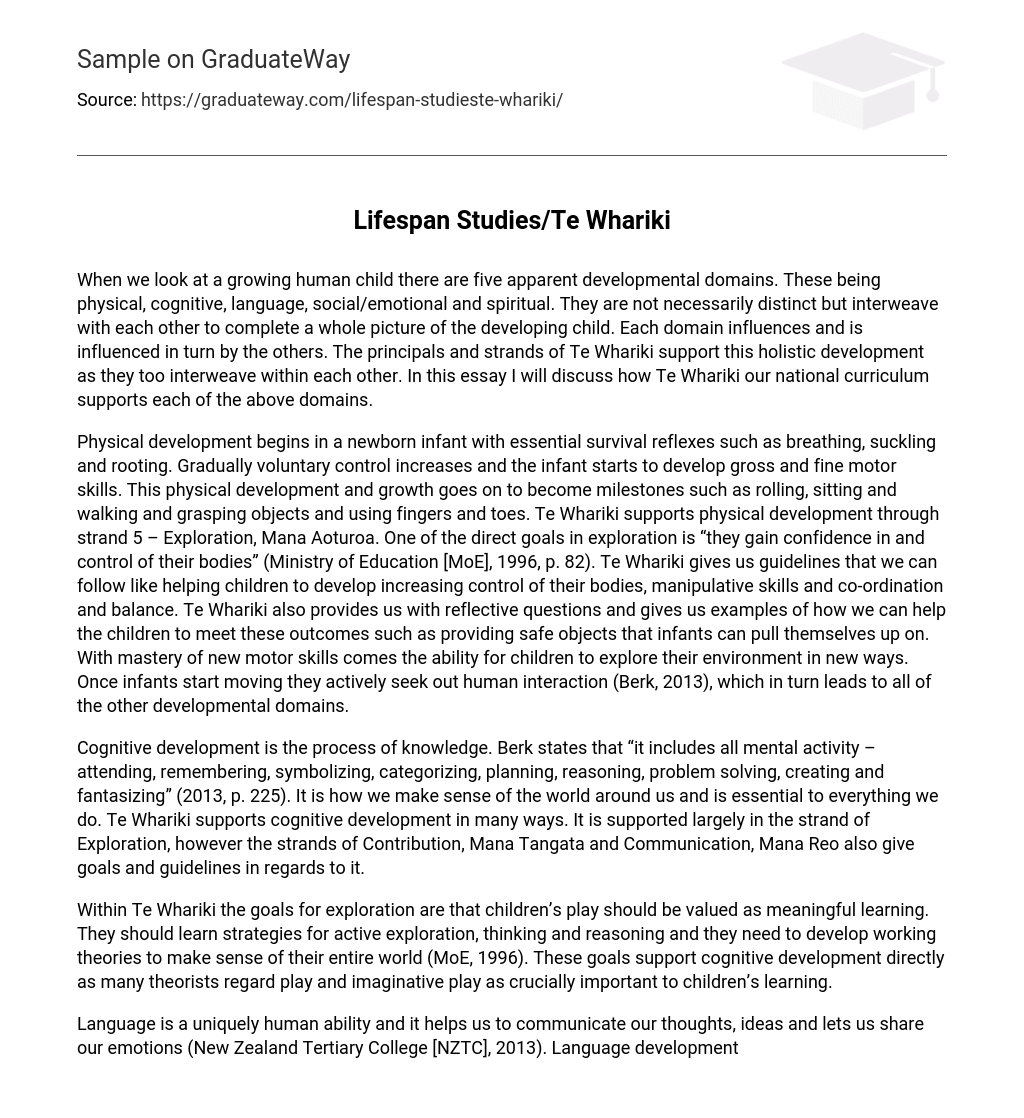When studying the progress of a human child, there are five specific areas that can be distinguished: physical development, cognitive development, language development, social/emotional development, and spiritual development. These domains are interconnected and collectively contribute to a comprehensive understanding of a growing child. Each area affects the others and is also influenced by them. The principles and components of our national curriculum, Te Whariki, embrace this holistic approach to development as they also interact with one another. This essay will examine how Te Whariki supports each of these areas.
Physical development in newborn infants begins with essential survival reflexes like breathing, suckling, and rooting. Over time, voluntary control improves and the infant develops gross and fine motor skills. This progress leads to milestones such as rolling, sitting, walking, grasping objects, and using fingers and toes. Te Whariki supports physical development through strand 5 – Exploration, Mana Aoturoa. One of the direct goals of exploration is for children to “gain confidence in and control of their bodies” (Ministry of Education [MoE], 1996, p. 82). Te Whariki provides guidelines for assisting children in developing body control, manipulative skills, coordination, and balance. Reflective questions and examples are also provided to help meet these outcomes, like offering safe objects for infants to pull themselves up on. Mastering new motor skills enables children to explore their environment in new ways. Once they begin moving, infants actively seek human interaction (Berk, 2013), which contributes to the other areas of development.
Berk (2013, p. 225) asserts that cognitive development comprises various mental activities such as attention, memory, symbolization, categorization, planning, reasoning, problem-solving, creativity, and fantasizing. These activities are crucial for understanding the world and have an influence on all aspects of our lives. In Te Whariki, New Zealand’s early childhood curriculum, cognitive development is nurtured through different strands. Although the Exploration strand concentrates on this domain specifically, other strands like Contribution,Māna Tangata , Communication,and Māna Reo also contribute to objectives and principles associated with cognitive development.
Te Whariki emphasizes the significance of valuing children’s play as a valuable learning experience and promoting methods that encourage active exploration, thinking, and reasoning. It also highlights the importance of children developing working theories to enhance their understanding of the world. Research suggests that play, particularly imaginative play, plays a vital role in children’s cognitive development.
Language is essential for humans as it allows us to communicate thoughts, ideas, and emotions (New Zealand Tertiary College [NZTC], 2013). It is particularly crucial for children as it enables them to express their needs and desires and articulate themselves. According to Chomsky, children possess an innate language acquisition device (LAD) that helps them understand and create sentences (Berk, 2013).
Te Whariki’s Communication strand supports the development of language, aiming for children to acquire communication skills for various purposes (MoE, 1996, p.16). Additionally, Te Whariki promotes learning outcomes such as proficiency in real-life situations, play, problem-solving, expressing emotions, negotiation, prediction, planning, and storytelling (MoE ,1996). These goals and learning outcomes contribute to enhancing and nurturing children’s language development. Te Whariki also recognizes the importance of Te Reo Maori as a relevant language (MoE ,1996).
Social and emotional development is also vital in early childhood. Te Whariki acknowledges this domain by incorporating it into its entire curriculum through a holistic view of the child. All principles and strands of Te Whariki contribute in some way to the social and emotional development of children. Emotions have a significant impact on our personality and social abilities as humans.According to Maslow’s hierarchy of needs, meeting a child’s basic needs is crucial for them to feel safe and secure (NZTC, 2013). Te Whariki supports this idea in strands 1 and 2 by promoting well-being, Mana Atua, and fostering a sense of belonging, Mana Whenua. The document emphasizes the importance of promoting children’s health (p.48), nurturing their emotional well-being (MoE, 1996, p.50), and providing them with a sense of place and belonging (MoE, 1996, p.54). When these goals are accomplished, children will experience a sense of belongingness and develop self-esteem and approval which will enable effective learning and success (NZTC, 2013).
Spiritual development is a mysterious aspect of growth that is challenging to define but is essential for teachers to acknowledge and foster in young children (NZTC, 2013). While it can refer to religious beliefs, spirituality is more broadly seen as the display of admirable human qualities such as love, generosity, forgiveness, sharing, peacefulness, and reverence for nature and its creatures (Wolf, 2000). As early childhood educators, it is our duty to cultivate this spiritual aspect, which is supported by our national curriculum Te Whariki. The first strand of the curriculum, Well-being, recognizes the significance of spirituality in the holistic development of children (MoE, 1996). Additionally, teaching across all strands of Te Whariki involves nurturing attributes like respect, curiosity, trust, reflection, confidence, independence, responsibility, and a sense of belonging (MoE, 1996).
Te Whariki supports the various developmental domains in multiple ways, ultimately recognizing their interconnections and interconnectedness. Its principles and strands, including Well-being, Belonging, Contribution, Communication, and Exploration, all intertwine and can be linked to any of the five developmental areas. By perceiving children as holistic beings, we, as early childhood teachers, should nurture their growth and development comprehensively. Te Whariki serves as our national curriculum, providing guidance in this endeavor.
Reference List
Berk, L. E. (2013). Child development. (9th ed.). Boston, MA: Pearson Education Inc.
Ministry of Education. (1996). Te Whāriki: He whāriki mātauranga mō nga mokopuna o Aotearoa/Early childhood curriculum. Wellington: Learning Media.
New Zealand Tertiary College. (2013). Lifespan studies 1 study guide. Auckland, New Zealand: New Zealand Tertiary College.
Wolf, A.D. (2000). How to nurture the spirit in non-sectarian environments. Young Children, 55(1), 34-36.





